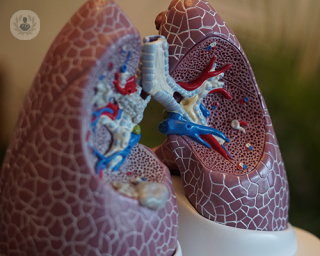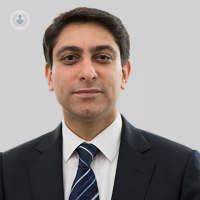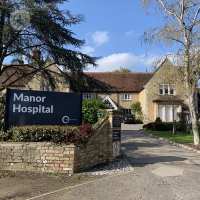What is an endobronchial ultrasound?
Endobronchial ultrasound is used to visualise the inside of the lungs and is often required when diagnosing lung cancer and other lung diseases. It is performed by pulmonologists and specialists in respiratory medicine. The procedure takes samples from the lungs or the lymph nodes in the chest. It can detect non-cancerous conditions such as sarcoidosis or tuberculosis.

What happens during an endobronchial ultrasound?
Before the procedure, you will be given a local anaesthetic and after it has taken effect a bronchoscope, which is a long flexible tube with a camera on the end, will be passed gently into your mouth and back into your throat.
After the throat has been examined, more anaesthetic will be given and the bronchoscope will be passed down the windpipe, into the bronchial tubes. You will be able to breathe but you will not be able to talk. The doctor will be able to see the images from the bronchoscope on a TV screen.
A collection of cells from the lymph nodes are then taken, which are then analysed in a laboratory to check for signs of cancer.
When will I receive the test results?
The results from an endobronchial ultrasound should be received within 2-3 weeks. You will be asked to see your consultant and discuss the results in the hospital.
Are there any risks to having an endobronchial ultrasound?
Endobronchial ultrasound is a safe procedure but sometimes there are side effects and in rare cases, complications. Side effects may include coughing during the procedure and having a sore throat for a few days afterwards.
Very rare complications (about 1 in 5 patients per 1000 bronchoscopies) may include bleeding or collapse of the lung following a biopsy. Other complications may include infection or an allergic reaction to the local anaesthetic.
Endobronchial ultrasound
Dr Neal Navani - Pulmonology & respiratory medicine
Created on: 03-01-2017
Updated on: 08-17-2023
Edited by: Sophie Kennedy
What is an endobronchial ultrasound?
Endobronchial ultrasound is used to visualise the inside of the lungs and is often required when diagnosing lung cancer and other lung diseases. It is performed by pulmonologists and specialists in respiratory medicine. The procedure takes samples from the lungs or the lymph nodes in the chest. It can detect non-cancerous conditions such as sarcoidosis or tuberculosis.

What happens during an endobronchial ultrasound?
Before the procedure, you will be given a local anaesthetic and after it has taken effect a bronchoscope, which is a long flexible tube with a camera on the end, will be passed gently into your mouth and back into your throat.
After the throat has been examined, more anaesthetic will be given and the bronchoscope will be passed down the windpipe, into the bronchial tubes. You will be able to breathe but you will not be able to talk. The doctor will be able to see the images from the bronchoscope on a TV screen.
A collection of cells from the lymph nodes are then taken, which are then analysed in a laboratory to check for signs of cancer.
When will I receive the test results?
The results from an endobronchial ultrasound should be received within 2-3 weeks. You will be asked to see your consultant and discuss the results in the hospital.
Are there any risks to having an endobronchial ultrasound?
Endobronchial ultrasound is a safe procedure but sometimes there are side effects and in rare cases, complications. Side effects may include coughing during the procedure and having a sore throat for a few days afterwards.
Very rare complications (about 1 in 5 patients per 1000 bronchoscopies) may include bleeding or collapse of the lung following a biopsy. Other complications may include infection or an allergic reaction to the local anaesthetic.


Why would I need an endobronchial ultrasound (EBUS)?
By Dr Tuck-Kay Loke
2024-12-21
An endobronchial ultrasound (EBUS) is a highly effective diagnostic procedure with many different applications that has become widely used in the UK. Here, consultant respiratory physician Dr Tuck-Kay Loke, provides an expert insight into the EBUS procedure. See more


Modern lung cancer diagnosis: faster, safer, more accurate
By Dr Neal Navani
2024-12-15
In recent years, diagnosing lung cancer has become much more accurate and straightforward, leading to more effective treatment. Dr Neal Navani, one of London’s top respiratory physicians, is here to explain how the diagnosis process works and what to expect. See more
Experts in Endobronchial ultrasound
-
Dr Neal Navani
Pulmonology & respiratory medicineExpert in:
- Endobronchial ultrasound
- Lung cancer
- Chronic cough
- Bronchoscopy
- Asthma
- Respiratory diseases
-
Dr Enson Thomas
Pulmonology & respiratory medicineExpert in:
- Cough
- Sleep disorders
- Lung cancer
- Asthma
- Bronchoscopy
- Endobronchial ultrasound
-
Dr James Murray
Pulmonology & respiratory medicineExpert in:
- Lung cancer
- Lung diseases
- Pleural effusion
- Pneumonia
- Bronchoscopy
- Endobronchial ultrasound
- See all

The Manor Hospital - part of Circle Health Group
The Manor Hospital - part of Circle Health Group
Church End, Biddenham, Bedford MK40 4AW
No existe teléfono en el centro.
By using the telephone number provided by TOP DOCTORS, you automatically agree to let us use your phone number for statistical and commercial purposes. For further information, read our Privacy Policy
Top Doctors

Cleveland Clinic Portland Place Outpatient Centre
Cleveland Clinic Portland Place Outpatient Centre
24 Portland Place, W1B 1LU
No existe teléfono en el centro.
By using the telephone number provided by TOP DOCTORS, you automatically agree to let us use your phone number for statistical and commercial purposes. For further information, read our Privacy Policy
Top Doctors

Cleveland Clinic London Hospital
Cleveland Clinic London Hospital
33 Grosvenor Place
No existe teléfono en el centro.
By using the telephone number provided by TOP DOCTORS, you automatically agree to let us use your phone number for statistical and commercial purposes. For further information, read our Privacy Policy
Top Doctors
-
The Manor Hospital - part of Circle Health Group
Church End, Biddenham, Bedford MK40 4AW, BedfordExpert in:
- General Surgery
- Orthopaedic surgery
- Physiotherapy
- Obstetrics and Gynaecology
- General practice
- Urology
-
Cleveland Clinic Portland Place Outpatient Centre
24 Portland Place, W1B 1LU, Central LondonExpert in:
- Diagnosis of Cancer
- Diagnostics
- Women’s health
- Sports Medicine
- General practice
- Health check up
-
Cleveland Clinic London Hospital
33 Grosvenor Place, Central LondonExpert in:
- Cardiology
- Colorectal surgery
- Minimal access surgery (keyhole surgery)
- Gallbladder surgery
- Diagnostic Imaging
- Ultrasound
- See all
- Most viewed diseases, medical tests, and treatments
- Autoimmune diseases
- Long Covid
- Respiratory failure
- Sleep disorders
- Lung cancer
- Sleep apnoea
- Pulmonary nodule
- Chronic fatigue
- Chronic cough
- Lung function test





